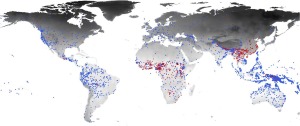
A new report published in the Proceedings of the National Academy of Sciences of the United States of America links the evolution of tonal languages to climate, specifically to heat and humidity. The report, “Climate, Vocal Folds, and Tonal Languages: Connecting the Physiological and Geographic Dots,” is the collaboration of linguists hailing from the U.S., Germany, and the Netherlands, and builds off of previous research that correlated the physiology of vocal folds in the larynx, also known as the voice box, to ambient air conditions; more hydrated vocal folds are able have a more robust amplitude for vibration, and therefore effects the speaker’s ability to produce certain sounds. Previous studies have also noted that inhaling dry air affects vocal folds, as it dries out mucous membranes. This study predicts that climatic factors can hinder the use of phonemic tone, and that humid and hot climates would have been more hospitable to the evolution of tonal languages over time.
The researchers looked at 3,750 languages from across language families to investigate the correlation between humidity and tonal languages— languages in which pitch affects lexical meaning [consider the Chinese tongue twister māma mà mǎ de má ma? (Is Mom scolding the horse’s hemp?)]. They also looked at complex tonal languages, which have three or more pitch-based phonemic contrasts. In mapping their findings, the researchers show that tonal languages had developed in humid regions, such as tropical and subtropical parts of Asia and Africa.
This new research posits that language is ecologically adaptive, connecting the precise manipulations of vocal folds that are required to produce tones to climate.
Complex tones would be more difficult to produce in dry and cold climates, while they would be easier to produce in humid and warm place. This study has far-reaching implications because it goes against the general belief in the linguistic community that sound systems of human languages are not ecologically adaptive. The researchers are suggesting a causal relationship between climate and the sounds in human languages.


